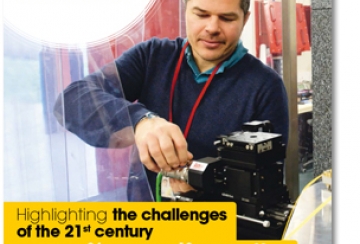
PUMA (French for "Photons Utilisés pour les Matériaux Anciens") is a hard X-ray imaging beamline optimized for the scientific communities of the hertitage sciences. The 2d imaging endstation will offer a resolution of several microns with elemental (XRF), chemical (XANES) and structural (XANES and XRD) contrast. In the future, a second endstation for 3d imaging will be added.
The PUMA beam line (French for "Photons Utilisés pour les Matériaux Anciens" - photons used for ancient materials) is currently in the last part of the construction phase. It will open to expert users in the end of 2018.
The first experimental station to open to users will be a 2d imaging hard X-ray micro focus station, focalizing the X-rays to a 3 µm (horizontal) x 1.5 µm (vertical) spot. The analytical techniques available to the users will be X-ray fluorescence spectroscopy (XRF), X-ray absorption near-edge structure (XANES) and X-ray powder diffraction (XRD). The X-ray energy will be tuneable from 4 to 23 keV. Flyscan techniques will insure fast data acquisition. A state of the art fluorescence microscope will be available for in-situ sample observation.
A second experimental station for 3d imaging with X-ray energies up to 60 keV will be added in the future. This station will aim to provide micron resolution with a focus on in-line phase contrast imaging.
 The beamline has been constructed and will be operated in collaboration with the IPANEMA laboratory. In the future, it will contribute researchers and engineers to the PUMA staff.
The beamline has been constructed and will be operated in collaboration with the IPANEMA laboratory. In the future, it will contribute researchers and engineers to the PUMA staff.
Acknowledgments
The construction of the PUMA beamline has been financed by the region île-de-France and the French state through the CPER 20017 - 2013 program.
The equipment of the micro focusing station is property of the CNRS and has been financed by the PATRIMEX equipped grant in the framework of the “Investissements d'Avenir” program of the “Agence Nationale de la Recherche” (ANR).




Team
Technical data
4 - 23 keV micro beam endstation
4 - 60 keV full field endstation
Wiggler W164.2mm×20 periods, B = 1.8 T, medium section
White beam
Monochromatic beam : Double crystal monochromator (DCM) Si111 (4-20 keV) and Si220 (20-60 keV)
Diaphragm 1.45×2.8 mm² (H×V) @ 17 m
Beryllium window : Be 300 µm @ 19 m
Removable filter : CVD 1000 µm @ 19 m
Primary slits @ 19.5 m
Horizontal mirror @ 21 m : θ = 1.3 mrad fixe, longeur focale variable.
DCM @ 22.5 m : Si 111 ou Si 220
Secondary slits @ 24 m
Tertiary slits @ 40 m
KB mirror @ 63 m : B4C 60 nm ou Rh 60 nm layer
Sample @ 63.3 m
X-ray fluorescence spectroscopy (XRF)
X-ray absorption spectroscopy (XANES)
X-ray powder diffraction (XRD)
Micro beam with KB mirror system : 3 µm x 1,5 µm (HxV)
Full field : Max. field of view 20 mm x 12 mm (HxV)
Scientific opportunities
- Archeology
- Paleontology
- Paleo-environments
- Conservation sciences


